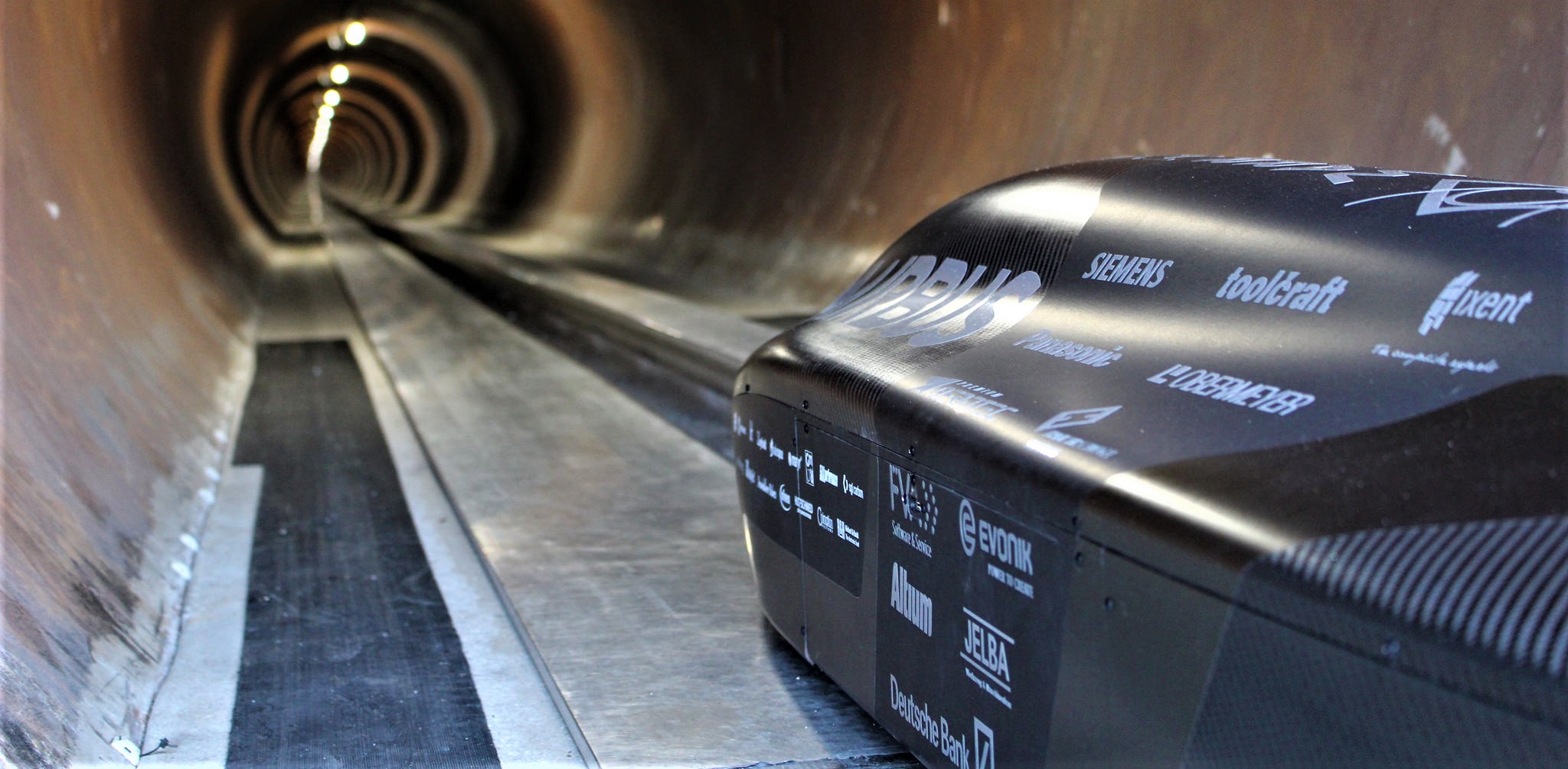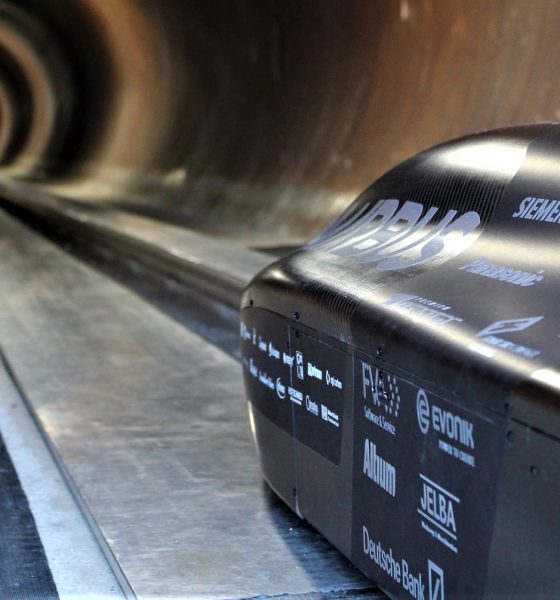

News
SpaceX to build massive, new Hyperloop tunnel for 2020 competition, says Elon Musk
SpaceX just completed its fourth hosted Hyperloop competition since its 2017 debut and Hyperloop inventor and CEO Elon Musk capped the successful event with a big claim: in 2020, SpaceX plans to host Competition 5 at a brand-new vacuum tunnel that could offer all kinds of new opportunities to next year’s student teams.
According to Musk, that new track – presumably to be built by The Boring Company with SpaceX help – could be up to 10 km (6.2 mi) in length, will support a full vacuum like its 1.6 km (1 mi) predecessor, and will feature a curved track. Altogether, those features could support truly insane top speeds and allow teams to test pods with far more realistic acceleration profiles relative to those that have been tested at SpaceX’s track in the last few years. Furthermore, Musk specifically described the new track as a “10km vacuum tunnel”, immediately bringing to mind the obvious possibility of a new Boring Company collaboration.
As mentioned above, SpaceX just wrapped up its fourth Hyperloop competition in two years. Of the 21 teams that won slots in the event, only four were judged by SpaceX to be ready for speed runs. Of those four, the German team TUM Hyperloop (formerly WARR Hyperloop) reached a top speed of 288 mph (463 km/h, 128 m/s) before the pod suffered visible damage and performed a flawless emergency stop, pulling dozens of Gs and coming to a halt in just 50-100m.
In a nominal outcome, TUM Hyperloop anticipated that their fourth-generation pod could reach a top speed of more than half the speed of sound (~380+ mph, 600+ km/h). In 2018, they achieved a spectacular top speed of 290 mph, just slightly edging out Pod IV’s pre-anomaly performance this year. The runner-up, Swissloop, reached a still-impressive top speed of ~160 mph (260 km/h), a demonstrating of just how far ahead of its peers TUM/WARR remains.
At the end of the day, speed records are just icing on the Hyperloop Competition cake, following the main motivation of offering an almost unbeatable applied engineering learning opportunity for student groups around the world.
Hyperloop Alpha?
Assuming SpaceX and/or The Boring Company manage to pull off a minor engineering miracle and successfully build a “10km vacuum tunnel” in a single year, the company will have easily set itself up to host countless more competitions in the coming years. Additionally, assuming that “tunnel” refers to a full-scale tunnel capable of being built by The Boring Company, SpaceX’s new Hyperloop test facilities will be at or very near full-scale relative to the operational, human-rated transportation system that is the concept’s ultimate goal.
The test tunnel quite literally bored under the current above-ground Hyperloop track has a final usable diameter of 12 feet (3.7m), more than double the 6-foot (1.8m) diameter of the track currently used for competitions. Additionally, it would be even larger than Hyperloop One’s ~11 foot (3.3m) diameter Nevada test track. Ultimately, such a large tunnel would simultaneously give The Boring Company experience with building a true vacuum tunnel system and provide an opportunity for full-scale vacuum train (i.e. hyperloop) testing over unprecedented distances.
Maybe, just maybe, Elon Musk is thinking about putting a bit more time into turning his original Hyperloop concept into a finished product.
Check out Teslarati’s Marketplace! We offer Tesla accessories, including for the Tesla Cybertruck and Tesla Model 3.

Elon Musk
Elon Musk’s X will start using a Tesla-like software update strategy
The initiative seems designed to accelerate updates to the social media platform, while maintaining maximum transparency.

Elon Musk’s social media platform X will adopt a Tesla-esque approach to software updates for its algorithm.
The initiative seems designed to accelerate updates to the social media platform, while maintaining maximum transparency.
X’s updates to its updates
As per Musk in a post on X, the social media company will be making a new algorithm to determine what organic and advertising posts are recommended to users. These updates would then be repeated every four weeks.
“We will make the new 𝕏 algorithm, including all code used to determine what organic and advertising posts are recommended to users, open source in 7 days. This will be repeated every 4 weeks, with comprehensive developer notes, to help you understand what changed,” Musk wrote in his post.
The initiative somewhat mirrors Tesla’s over-the-air update model, where vehicle software is regularly refined and pushed to users with detailed release notes. This should allow users to better understand the details of X’s every update and foster a healthy feedback loop for the social media platform.
xAI and X
X, formerly Twitter, has been acquired by Elon Musk’s artificial intelligence startup, xAI last year. Since then, xAI has seen a rapid rise in valuation. Following the company’s the company’s upsized $20 billion Series E funding round, estimates now suggest that xAI is worth tens about $230 to $235 billion. That’s several times larger than Tesla when Elon Musk received his controversial 2018 CEO Performance Award.
As per xAI, the Series E funding round attracted a diverse group of investors, including Valor Equity Partners, Stepstone Group, Fidelity Management & Research Company, Qatar Investment Authority, MGX, and Baron Capital Group, among others. Strategic partners NVIDIA and Cisco Investments also continued support for building the world’s largest GPU clusters.
News
Tesla FSD Supervised wins MotorTrend’s Best Driver Assistance Award
The decision marks a notable reversal for the publication from prior years, with judges citing major real-world improvements that pushed Tesla’s latest FSD software ahead of every competing ADAS system.

Tesla’s Full Self-Driving (Supervised) system has been named the best driver-assistance technology on the market, earning top honors at the 2026 MotorTrend Best Tech Awards.
The decision marks a notable reversal for the publication from prior years, with judges citing major real-world improvements that pushed Tesla’s latest FSD software ahead of every competing ADAS system. And it wasn’t even close.
MotorTrend reverses course
MotorTrend awarded Tesla FSD (Supervised) its 2026 Best Tech Driver Assistance title after extensive testing of the latest v14 software. The publication acknowledged that it had previously criticized earlier versions of FSD for erratic behavior and near-miss incidents, ultimately favoring rivals such as GM’s Super Cruise in earlier evaluations.
According to MotorTrend, the newest iteration of FSD resolved many of those shortcomings. Testers said v14 showed far smoother behavior in complex urban scenarios, including unprotected left turns, traffic circles, emergency vehicles, and dense city streets. While the system still requires constant driver supervision, judges concluded that no other advanced driver-assistance system currently matches its breadth of capability.
Unlike rival systems that rely on combinations of cameras, radar, lidar, and mapped highways, Tesla’s FSD operates using a camera-only approach and is capable of driving on city streets, rural roads, and freeways. MotorTrend stated that pure utility, the ability to handle nearly all road types, ultimately separated FSD from competitors like Ford BlueCruise, GM Super Cruise, and BMW’s Highway Assistant.
High cost and high capability
MotorTrend also addressed FSD’s pricing, which remains significantly higher than rival systems. Tesla currently charges $8,000 for a one-time purchase or $99 per month for a subscription, compared with far lower upfront and subscription costs from other automakers. The publication noted that the premium is justified given FSD’s unmatched scope and continuous software evolution.
Safety remained a central focus of the evaluation. While testers reported collision-free operation over thousands of miles, they noted ongoing concerns around FSD’s configurable driving modes, including options that allow aggressive driving and speeds beyond posted limits. MotorTrend emphasized that, like all Level 2 systems, FSD still depends on a fully attentive human driver at all times.
Despite those caveats, the publication concluded that Tesla’s rapid software progress fundamentally reshaped the competitive landscape. For drivers seeking the most capable hands-on driver-assistance system available today, MotorTrend concluded Tesla FSD (Supervised) now stands alone at the top.
News
Elon Musk’s Grokipedia surges to 5.6M articles, almost 79% of English Wikipedia
The explosive growth marks a major milestone for the AI-powered online encyclopedia, which was launched by Elon Musk’s xAI just months ago.

Elon Musk’s Grokipedia has grown to an impressive 5,615,201 articles as of today, closing in on 79% of the English Wikipedia’s current total of 7,119,376 articles.
The explosive growth marks a major milestone for the AI-powered online encyclopedia, which was launched by Elon Musk’s xAI just months ago. Needless to say, it would only be a matter of time before Grokipedia exceeds English Wikipedia in sheer volume.
Grokipedia’s rapid growth
xAI’s vision for Grokipedia emphasizes neutrality, while Grok’s reasoning capabilities allow for fast drafting and fact-checking. When Elon Musk announced the initiative in late September 2025, he noted that Grokipedia would be an improvement to Wikipedia because it would be designed to avoid bias.
At the time, Musk noted that Grokipedia “is a necessary step towards the xAI goal of understanding the Universe.”
Grokipedia was launched in late October, and while xAI was careful to list it only as Version 0.1 at the time, the online encyclopedia immediately earned praise. Wikipedia co-founder Larry Sanger highlighted the project’s innovative approach, noting how it leverages AI to fill knowledge gaps and enable rapid updates. Netizens also observed how Grokipedia tends to present articles in a more objective manner compared to Wikipedia, which is edited by humans.
Elon Musk’s ambitious plans
With 5,615,201 total articles, Grokipedia has now grown to almost 79% of English Wikipedia’s article base. This is incredibly quick, though Grokipedia remains text-only for now. xAI, for its part, has now updated the online encyclopedia’s iteration to v0.2.
Elon Musk has shared bold ideas for Grokipedia, including sending a record of the entire knowledge base to space as part of xAI’s mission to preserve and expand human understanding. At some point, Musk stated that Grokipedia will be renamed to Encyclopedia Galactica, and it will be sent to the cosmos.
“When Grokipedia is good enough (long way to go), we will change the name to Encyclopedia Galactica. It will be an open source distillation of all knowledge, including audio, images and video. Join xAI to help build the sci-fi version of the Library of Alexandria!” Musk wrote, adding in a later post that “Copies will be etched in stone and sent to the Moon, Mars and beyond. This time, it will not be lost.”








